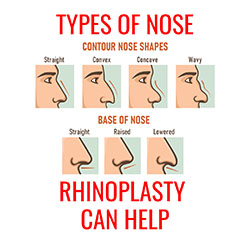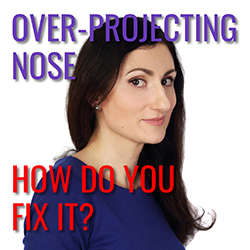Botched Nose Jobs

Rhinoplasty is a common plastic surgery procedure chosen by millions of people worldwide to improve their nasal shape. Most nose job procedures deliver the desired results. But the possibility of a revision is still there, with 5 to 10 percent of people requiring a second operation.
Does Skin Thickness Affect Rhinoplasty?

The shape of the nose depends on the bone and cartilage skeleton and the skin that drapes over it. Rhinoplasty is the surgical intervention that modifies the underlying bone and cartilage architecture.
Also known as a nose job, rhinoplasty is one of the more difficult cosmetic surgical procedures to perform. Every nose is different and everyone has different goals. The thickness of the nasal skin is one factor that affects the outcome and must be considered in the surgeon’s operative plan.
What Types of Nose Shape Can Rhinoplasty Help?

When it comes to the aesthetic imperfections of the nose, the most commonly reported concerns are size, shape, straightness, and overall elegance. In addition to these, there are many other reasons why people choose to have rhinoplasty. Cosmetic nasal surgery is one of the more difficult surgical procedures that one can have on the face. For one thing, the nose is a central feature of the face and flaws are more noticeable and harder to conceal than other imperfections. Equally important, rhinoplasty itself is difficult because it requires an understanding of how the external appearance will change given modifications of the internal bone and cartilage framework.
Functional vs. Cosmetic Rhinoplasty: What’s the Difference?

Plastic surgery on the nose, or rhinoplasty, may be performed to improve the size/shape/elegance of the nose or to improve breathing…OR both.
Can I Get My Favorite Celebrity’s Nose With A Rhinoplasty?

Many people assume that celebrities get exclusive nose jobs that deliver them better outcomes than the rest of us. Patients often visit surgeons who specialize in cosmetic surgery with photographs of celebrities and say things like, “I want a tip just like hers”, or “This is the nose that I want”.
Correcting Supratip or pollybeak deformity with Rhinoplasty

The ideal contour of the nasal bridge, when viewed from the side, is either straight (particularly in men) or straight with a slight upturn at the tip (particularly in women). If the area just above the tip (the supra tip region) projects slightly more than the tip, then the pollybeak deformity or supratip deformity occurs and the nose does not appear attractive in profile. This terminology is frequently used when referring to a nose that has already undergone a rhinoplasty and the supratip area remains too high, resulting in a convexity to the bridge and/or the appearance of a plunging tip. See below and find out how Rhinoplasty corrects a supratip nose deformity.
What Can You Do About Flared Nostrils?

Do you have distinctly flared nostrils? Widely flaring nostrils can be repaired by a rhinoplasty maneuver called an alar base resection or anaplasty. But let’s make sure we are talking about the same thing because communication between the doctor and the patient is key to success.
What is an Over-Projecting Nose and How Do You Fix It?

Does your nose seem too big for your face?
When people think their noses are too big there are three possible dimensions or measurements that can be excessive: The length (the distance from where the nose starts below the forehead to the nasal tip), the width (as viewed from the front), and the PROJECTION (the distance the nose sticks out into space). Some large noses are large in one dimension and some in all three. The nose that is not too long and not too wide but just sticks out too much is sometimes called the Pinocchio nose. Obviously, the length and projection are most easily judged on the side profile whereas the width is best judged from the front.
Rhinoplasty for a Saddle Nose

Rhinoplasty is a surgical procedure that alters your nasal shape and/or improves your breathing. Since noses come in different shapes and sizes, people seek rhinoplasty for different reasons. Some nasal shapes are more common in specific ethnic groups and some undesirable nasal shapes are the result of previous rhinoplasty surgery that may have been overdone or inexpertly performed. One such characteristic shape is the “saddle nose.”
Closed or Open Rhinoplasty: What is the Difference?

Rhinoplasty, more commonly known as a “nose job”, is a procedure during which the appearance and/or function of your nose is/are modified by manipulating the nasal bones and cartilages. There are two main approaches that your plastic surgeon can use to gain access to your nasal structures: 1) the closed or 2) the open approach. The two techniques are more similar than they are different but patients frequently ask questions about when one technique is the most appropriate.